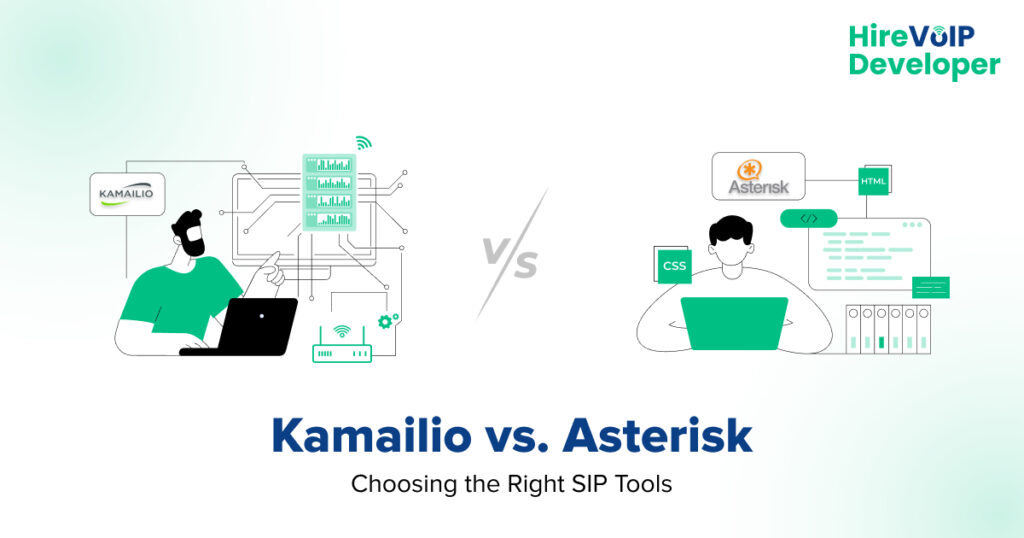📝 Blog Summary
Comparing Kamailio vs Asterisk isn’t about which is better; it’s about where they fit. This blog explains their roles, how they work together, and when to use both. (Ideal for VoIP architects building scalable SIP infrastructure!)
People often group Kamailio and Asterisk into the same mental box, but in practice, they solve very different problems.
If you’re comparing Kamailio vs Asterisk, the real question is this:
Are you trying to manage signaling?
Or, are you trying to process the actual calls?
Kamailio is what you’d use to direct SIP traffic: register endpoints, route INVITEs, act as a SIP firewall, or balance loads between multiple nodes.
Asterisk, on the other hand, handles call logic: things like IVRs, bridging, voicemail, conferencing, and audio.
Kamailio and Asterisk are built for different layers of your VoIP architecture. And when you combine them the right way, you can scale cleanly without stretching either system beyond its strengths.
Let’s break this down properly.
Asterisk vs Kamailio | What Do They Do?
You’ll often see Kamailio and Asterisk used together, but they’re not interchangeable. They live in different parts of your VoIP architecture.
Kamailio is built to handle SIP signaling at scale. It doesn’t care about the media. It doesn’t care about IVRs or voicemail. Its job is to process SIP messages (like INVITE, REGISTER, and OPTIONS) as fast as possible, route them correctly, and enforce policy. It’s used at the edge of your VoIP stack, where performance and control matter most.
Asterisk is a media-aware SIP application server. It handles audio. It plays messages. It records voicemail. It decides what happens when a call connects: bridging it, putting it on hold, or sending it to an IVR menu.
So if you’re asking Asterisk vs Kamailio, you’re really asking:
Do I need a SIP signaling engine? Or do I need something to handle call features?
In many modern deployments, you need both.
Why Kamailio Is Often the Better Front-End for Scale
If you’re starting with Asterisk, it may seem like all you need. However, as your system grows (with more endpoints, trunks, and regions), you begin to encounter signaling and performance bottlenecks.
Once your platform goes beyond a few thousand endpoints or starts dealing with multiple SIP carriers, Kamailio earns its place.
- It can handle 10x the signaling traffic that Asterisk can.
- It gives you real SIP routing logic, carrier-based routing, DID matching, and prefix-based failover.
- It acts as an SBC, removing rogue traffic before it ever hits Asterisk.
If you’re running FusionPBX, FreePBX, or a standalone Asterisk deployment in production and you’re hitting limitations, the answer usually starts with “put Kamailio in front of it.”
Need help integrating Kamailio and Asterisk into a clean VoIP architecture?
Kamailio vs Asterisk | Key Differences
When it comes to Kamailio vs Asterisk performance, the difference is clear:
- Kamailio can handle thousands of SIP messages per second with minimal CPU usage. It’s stateless, event-driven, and built for performance.
- Asterisk isn’t designed for raw signaling throughput. It’s built to control call flows and media, which means higher CPU usage per call, especially when transcoding is involved.
If you’re handling high call volumes and expecting to scale, you should consider using Kamailio as the front-end and Asterisk as the backend logic.
That’s why so many VoIP providers use Kamailio and Asterisk together. Kamailio takes the hit at the edge, handles NAT traversal, filters SIP scans, and routes to Asterisk only when needed.
Let’s make the architectural differences a bit clearer:
| Aspect | Kamailio | Asterisk |
|---|---|---|
| Role | SIP proxy, registrar, SBC, load balancer | Application server + media handler |
| SIP Functionality | Routes SIP messages only (no media) | Handles SIP signaling + media streams |
| Media Handling | ❌ No RTP/audio | ✅ Yes, audio bridging, mixing, playback |
| Performance at Scale | Excellent; handles thousands of CPS | Moderate; becomes CPU-bound under load |
| Use Case | Edge routing, NAT traversal, SIP firewall | IVRs, voicemail, conferencing, call control |
| Deployment Model | Stateless, horizontal scaling | Stateful, harder to scale |
When to Use Both? Kamailio Asterisk Integration
If you’re building anything more than a single-node PBX, you’ll eventually run into Asterisk’s limits. That’s when you start layering.
Here’s how it usually works:
- Kamailio handles registration, SIP authentication, routing, and NAT. It terminates the SIP connection with the endpoint and decides what to do next.
- Asterisk handles the business logic of the call, bridging two parties, playing prompts, triggering APIs, etc.
This separation gives you:
- More control over signaling and routing
- Better security at the edge
- Easier horizontal scaling
- Less load on Asterisk
This is the foundation of Kamailio Asterisk integration, allowing each system to do what it does best.
Common Kamailio and Asterisk Architectures
If you’re exploring a Kamailio and Asterisk setup for the first time, here are three patterns worth knowing:
- Kamailio as a SIP Front-End + Load Balancer
- Kamailio sits at the edge, authenticates users, and forwards calls to one of many Asterisk servers.
- This is classic Kamailio Asterisk load balancing; essential if you’re scaling to 10,000+ endpoints or doing regional failover.
- Kamailio as SBC in Front of Asterisk
- You want Kamailio SBC and Asterisk structure where Kamailio enforces security rules, handles NAT traversal, and protects Asterisk from malformed traffic.
- This is common in multi-tenant VoIP platforms.
- Kamailio as Registrar + SIP Router
- Kamailio manages all user registrations and routing.
- Asterisk is only called when something needs audio (like a voicemail or IVR).
In all these cases, Asterisk is freed from handling edge traffic, allowing it to do what it’s good at: handling media and logic.
How to Set Up Kamailio and Asterisk Together?
Setting up a Kamailio and Asterisk integration isn’t just about pointing traffic from one to the other; it’s about syncing SIP behavior between both.
Here’s what you need to get right:
- Registration Handling: Let Kamailio handle REGISTER requests. It stores contact info and handles authentication.
- INVITE Routing: Kamailio routes INVITEs to Asterisk only when media or logic is needed.
- Header Consistency: Asterisk configuration for Kamailio needs to account for any rewritten SIP headers, especially From, To, and Contact.
- RTP Handling: If you’re not using RTPProxy or MediaProxy, Asterisk must be reachable for media. Make sure Kamailio is aware of NAT conditions.
- Shared Data Layer (Optional): You can share user/location tables between Kamailio and Asterisk via MySQL or Redis if you need tighter integration.
🔍 Still unsure which platform fits your use case?
You don’t pick between Asterisk vs Kamailio based on which one is “better.” You pick based on what part of the call flow you’re responsible for.
If you’re building IVRs, call queues, or handling media, you need Asterisk.
If you’re handling signaling, registrations, load balancing, and SIP security, you need Kamailio.
And if you’re doing both?
You need to architect them to work together properly, because when you get that handoff right, you can scale cleanly without hitting walls.
Need help architecting Kamailio as the front-end to your Asterisk-based platform?
Hire Kamailio Developers who’ve done this at scale and can build exactly what your SIP stack needs!


